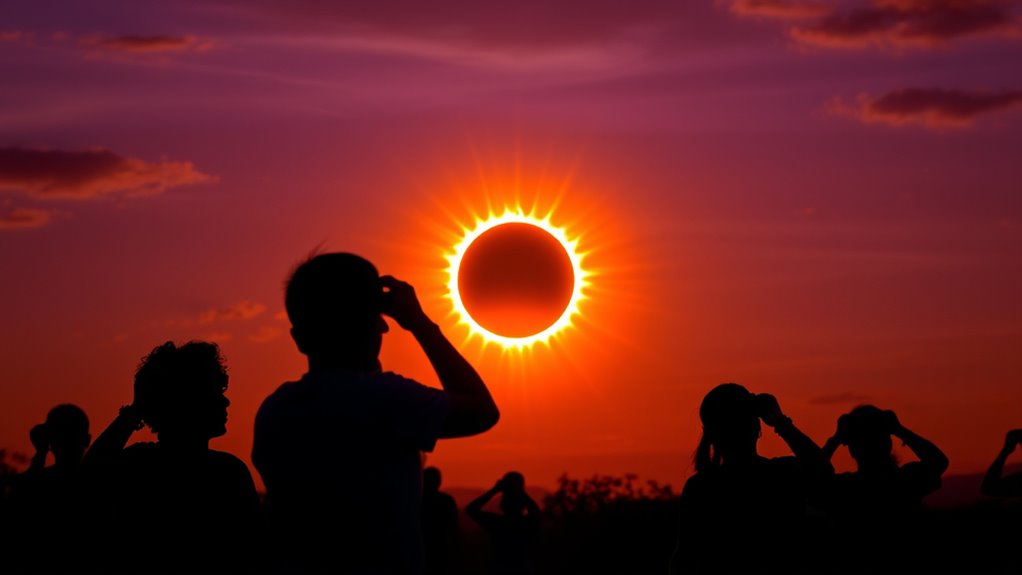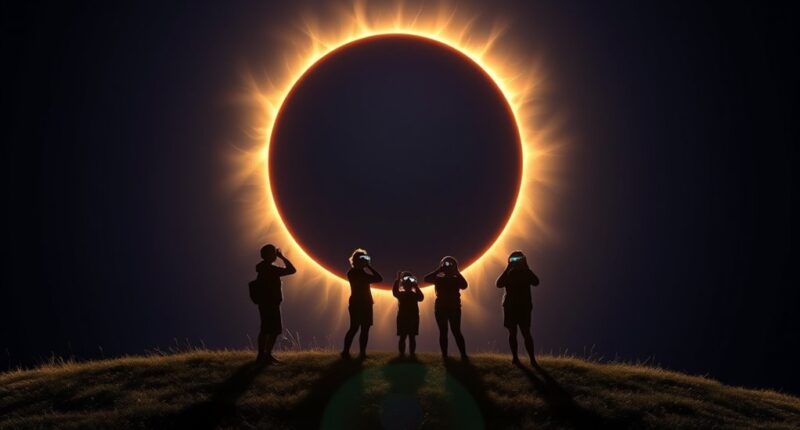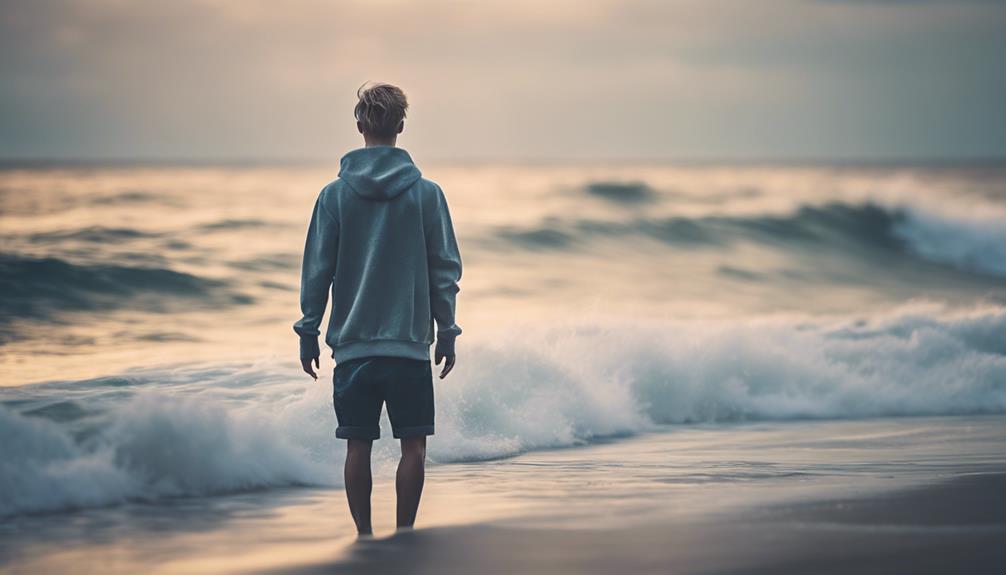NASA emphasizes the importance of proper eye protection during the 2026 solar eclipse. Never look directly at the sun without certified solar glasses that meet ISO 12312-2 standards. Regular sunglasses aren’t safe enough. Use solar filters for cameras and telescopes, and consider indirect viewing methods like pinhole projectors. Follow all safety guidelines carefully to prevent serious eye damage. Stay informed with official updates, and explore more ways to enjoy this rare event safely.
Key Takeaways
- NASA recommends using certified solar viewing glasses that meet ISO 12312-2 standards for eclipse safety.
- Never look directly at the eclipse without proper eye protection, including during partial or total phases.
- Use indirect viewing methods like pinhole projectors if unsure about safety gear or visibility conditions.
- Prepare and verify all equipment in advance, avoiding last-minute setups or untested filters.
- Follow official guidance from NASA and astronomical societies to ensure safe eclipse observation practices.

The Solar Eclipse of 2026 promises a spectacular celestial event that skywatchers around the world won’t want to miss. As the day approaches, it’s crucial to understand how to observe this rare phenomenon safely. NASA emphasizes the importance of eye protection, as looking directly at the sun without proper gear can cause serious, irreversible eye damage. You should never stare at the eclipse with the naked eye, even during the partial phases, because the sun’s rays are still intense enough to harm your vision. Instead, opt for certified solar viewing glasses that meet the ISO 12312-2 safety standard. These glasses block out harmful ultraviolet and infrared rays, making it safe to witness the eclipse directly.
Never look directly at the sun during an eclipse without certified solar glasses for eye safety.
When choosing your viewing locations, consider spots that offer unobstructed views of the sky, away from city lights and tall structures. Rural areas, parks, and open fields are ideal because they reduce light pollution and give you a clear line of sight. If you’re in a city, look for high rooftops or open spaces with a wide horizon. Remember, the best viewing experience comes from a location where the eclipse will be visible for the longest duration, so check local times and paths of visibility well in advance. Some regions will experience a total eclipse, while others will see only a partial eclipse, so knowing your specific location helps set your expectations.
In addition to eye protection, plan your viewing setup ahead of time. Bring along a pair of solar viewing glasses, a solar filter for telescopes or binoculars, or use indirect viewing methods like pinhole projectors. These alternatives allow you to enjoy the eclipse safely without risking eye injury. It’s also smart to arrive early at your chosen spot to secure a good viewing position and avoid last-minute crowds. Remember, never look through unfiltered cameras, binoculars, or telescopes without proper solar filters, as the concentrated sunlight can damage your eyes instantly.
Lastly, stay informed with updates from NASA and local astronomical societies. They often provide valuable tips on the best viewing practices and safe equipment. Understanding hydrogen fuel cells can help you appreciate sustainable energy sources that could someday power safe, eco-friendly equipment for celestial viewing. By taking these precautions responsibly and selecting appropriate viewing locations, you’ll be able to enjoy the awe-inspiring spectacle of the 2026 eclipse safely and comfortably. This celestial event offers a rare opportunity to witness the universe’s beauty—just make sure your eye protection is in place and your viewing spots are well chosen.
Frequently Asked Questions
Will the Eclipse Be Visible From My Specific Location?
You’re wondering if the eclipse will be visible from your location. Regional visibility depends on your area’s position relative to the eclipse path, and the eclipse timing varies by region. To find out, check local astronomical forecasts or NASA’s official maps. This way, you’ll know when the eclipse occurs in your region and whether you’ll get a chance to witness this spectacular event.
Are There Any Health Risks Besides Eye Damage?
You might think eye damage is the only concern, but there’s more to watch out for during a solar eclipse. Excessive solar exposure can also cause skin burns or dehydration if you’re outdoors too long without protection. While eye health is the top priority, remember that prolonged exposure to the sun’s rays can affect your overall well-being. Always follow safety guidelines to enjoy the eclipse safely and avoid unnecessary health risks.
How Long Will the Eclipse Last in Different Regions?
You might wonder about the solar eclipse’s viewing duration in different regions. The eclipse’s totality can last from a few seconds up to about 7 minutes, depending on your location. In some areas, the partial eclipse might last several hours. Your viewing duration varies based on your geographic position and the eclipse’s path, so check local timings to enjoy the event safely and fully.
Can I View the Eclipse Safely Without Glasses?
You should never view a solar eclipse without proper eye protection. Using solar filters or approved eclipse glasses is essential to safeguard your eyes from harmful rays. Homemade viewers or makeshift filters aren’t safe because they might not block enough light. Always guarantee your solar filters are compliant with safety standards, and avoid looking directly at the sun without proper protection. Your eye safety depends on it.
Will There Be Special Events or Guided Viewing Tours?
You can enjoy special events like viewing parties and guided tours to enhance your eclipse experience. Many communities and organizations plan these activities, offering expert-led sessions and safe viewing opportunities. Participating in guided tours can give you valuable insights into the eclipse’s science and significance. Check local event listings early to secure your spot, and remember to follow NASA’s safety guidelines for a safe and memorable viewing experience.
Conclusion
As you prepare to witness the 2026 solar eclipse, remember safety comes first. Just like Sarah, who looked directly at the eclipse without protection and endured a temporary vision loss, you can enjoy this rare event safely by following NASA’s guidelines. Use proper eclipse glasses or indirect viewing methods. Don’t risk your eyesight—prepare ahead and observe responsibly. This way, you’ll create unforgettable memories without any regrets.









